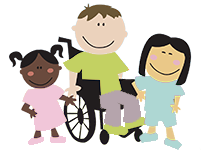[vc_row][vc_column][vc_column_text]
Childhood Apraxia – When Your Child Struggles to Speak
 Childhood apraxia is a speech disorder that causes children to have problems moving speech-related muscles correctly when speaking. The problem is not weak muscles; the brain itself sends incorrect signals to the body parts responsible for speech. Speech therapy is necessary to retrain childrens’ brains and to allow them to speak normally and without unnecessary struggles.
Childhood apraxia is a speech disorder that causes children to have problems moving speech-related muscles correctly when speaking. The problem is not weak muscles; the brain itself sends incorrect signals to the body parts responsible for speech. Speech therapy is necessary to retrain childrens’ brains and to allow them to speak normally and without unnecessary struggles.
Symptoms of Childhood Apraxia
Diagnosing childhood apraxia can be difficult since some of its symptoms overlap with other speech disorders. Watching for symptoms that are unique to childhood apraxia is the key to correctly detecting it. The inability to smoothly transition from one sound, syllable, or word to another is a key symptom of childhood apraxia. Vowel distortions or incorrect vowel sounds are another strong indicator. Difficulties with syllable-stressing – such as emphasizing the wrong syllable or emphasizing every syllable in the word – differentiate childhood apraxia from other speech disorders.
Causes of Childhood Apraxia
Determining the root cause of childhood apraxia can be difficult, and many professionals who successfully treat children with apraxia do not isolate the root cause. However, there are studies that show links between childhood apraxia and factors, including brain injuries, strokes, and genetic disorders. Childhood apraxia cannot be cured, but it can be treated with proper and consistent speech therapy.
Complications with Childhood Apraxia
Childhood apraxia can affect more than childrens’ speech. Childhood apraxia can hinder every aspect of their learning, including development of motor skills and difficulty with reading and writing. Childhood apraxia can also interfere with childrens’ coordination. Some patients with childhood apraxia are hypersensitive, reacting poorly when exposed to certain materials, fabrics, or sensations.
Treating Childhood Apraxia
The sooner that a child is diagnosed with, and treated for, childhood apraxia, the fewer complications the disorder will cause the child as they develop. Repeating sounds, syllables, and words for the child to learn helps train the child to make the correct sounds. Taking additional efforts to demonstrate how sounds and words are formed are effective at training the child to speak properly. Teaching the child the importance of cues – such as integrating mirrors into therapy or having the child learn hand gestures to reinforce how the mouth should move during specific sounds – can make learning more effective for the child. The practice of co-production – where the therapist and the child say a word at the same time – can further reinforce good speech habits.
If your child has childhood apraxia, contact our office at Speech and Occupational Therapy of North Texas to schedule a consultation and determine what treatment plan is best for your child.[/vc_column_text][/vc_column][/vc_row]
